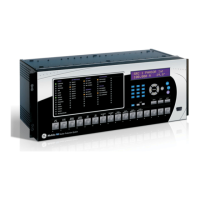9-2 F60 Feeder Protection System GE Multilin
9.1 TESTING 9 COMMISSIONING
9
The desired delay time is the interval from the point the frequency crosses the set threshold to the point the element oper-
ates. Some test sets can measure only the time from the ramp start to element operation, necessitating the subtraction of
the pre-threshold ramp time from the reading. For example, with a ramp rate of 0.20 Hz/s, start the ramp 0.20 Hz before the
threshold and subtract 1 second from test set time reading of ramp start to relay operation.
Note that the F60 event records only show the “pickup delay” component, a definite time timer. This is exclusive of the time
taken by the frequency responding component to pickup.
The F60 oscillography can be used to measure the time between the calculated source frequency crossing the threshold
and element operation; however, this method omits the delay in the calculated source frequency. The security features of
the source frequency measurement algorithm result in the calculated frequency being delayed by 2 to 4 cycles (or longer
with noise on the input). In addition, oscillography resolution is 0.004 Hz, which at 0.20 Hz/s corresponds to a delay of
20 ms. The tracking frequency should not be used in timing measurements, as its algorithm involves phase locking, which
purposely sets its frequency high or low to allow the F60 sample clock to catch-up or wait as necessary to reach synchro-
nism with the power system.

